May 5, 2016, Thursday — Pope Francis Celebrated Today in Rome the “Jubilee of Tears” — For All Who Weep and Are in Need of Consolation…
“Jesus wept.” —John 11:35, the shortest verse in the Bible. The verse describes the reaction of Jesus to the news of the death of his friend Lazarus, the brother of Martha and Mary, who lived in Bethany
“So the Jews said, ‘See how He loved him!'” —John 11:36, the reaction of the Jews to the sight of Jesus weeping
“‘Remove the stone,’ Jesus said. Martha, the dead man’s sister, told Him, ‘Lord, he’s already decaying. It’s been four days.’ Jesus said to her, ‘Didn’t I tell you that if you believed you would see the glory of God?'” —John 11:39-40, describing the conversation of Jesus with Martha, the sister of Lazarus, just before Jesus raises Lazarus from the dead
“Weep for the dead, for he hath lost the light, and weep for the fool, for he wanteth understanding; make little weeping for the dead, for he is at rest, but the life of the fool is worse than death.” —Ecclesiasticus, 22:11
“As Christ wept for Lazarus, let us also weep… Let us not become ferocious or relentless…. Besides, this is what Christ showed us, when he wept for Lazarus… This do also: weep but calmly, with comeliness and the fear of God.” —St. John Chrysostom, advising us to imitate the Lord when we are in sorrow and in mourning
“O God, grant me tears, and like the sinful woman make me worthy to moisten Your feet… that I may hear Your desirable voice: ‘Your faith has saved you, go in peace.'” —Doxastikon of Great Compline in the Orthodox tradition
“If God could weep, then I too can weep, in the knowledge that he understands me.” —Pope Francis, today in Rome, in his talk for the special “Jubilee of Tears,” dedicated to all who mourn
The Jubilee of Tears
The shortest verse in the Bible is John 11:35: “Jesus wept.”
Scholars and exegetes have spent much time and reflection on these two words, asking why Jesus wept, if he knew he was about to raise Lazarus.
Some say it was “to reveal the thoughts of all who followed Him, that is, how great of a suspicion they had toward him.”
But we do not know if this was the true reason for his weeping.
No explanation is given in scripture.
But it seems that Christ already knew that he would soon suffer his own passion and death, and wished to present, a few days beforehand, the message of his own resurrection.
By allowing Lazarus to die, by allowing him to lie four days in the tomb, Christ wished to show that he had authority over life ad death.
But the example he sets for us, even in the knowledge of His authority, is to weep.
Today in Rome, Pope Francis celebrated the “Jubilee of Tears.”
The Jubilee of those who weep.
And this is the talk he gave for the occasion.
“This is our poverty, but also our grandeur”
Talk given on the occasion of the “Jubilee of Tears,” Rome, May 5, 2016
By Pope Francis
Dear Brothers and Sisters,
After the moving testimonies we have heard, and in the light of the word of the Lord that gives meaning to our suffering, let us first ask Holy Spirit to come among us.
May He enlighten our minds to find the right words capable of bringing comfort.
May He open our hearts to the certainty that God is always present and never abandons us in times of trouble.
The Lord Jesus promised his disciples that he would not leave them alone, but at all times in life he would remain close to them by sending his Spirit, the Comforter (cf. Jn 14:26) to help, sustain and console them.
At times of sadness, suffering and sickness, amid the anguish of persecution and grief, everyone looks for a word of consolation.
We sense a powerful need for someone to be close and feel compassion for us.
We experience what it means to be disoriented, confused, more heartsick than we ever thought possible.
We look around us with uncertainty, trying to see if we can find someone who really understands our pain.
“Answers do not come”
Our mind is full of questions, but answers do not come.
Reason by itself is not capable of making sense of our deepest feelings, appreciating the grief we experience and providing the answers we are looking for.
At times like these, more than ever do we need the reasons of the heart, which alone can help us understand the mystery which embraces our loneliness.
How much sadness we see in so many faces all around us!
How many tears are shed every second in our world; each is different but together they form, as it were, an ocean of desolation that cries out for mercy, compassion and consolation.
The bitterest tears are those caused by human evil: the tears of those who have seen a loved one violently torn from them; the tears of grandparents, mothers and fathers, children; eyes that keep staring at the sunset and find it hard to see the dawn of a new day.
We need the mercy, the consolation that comes from the Lord.
All of us need it.
This is our poverty but also our grandeur: to plead for the consolation of God, who in his tenderness comes to wipe the tears from our eyes (cf. Is 25:8; Rev 7:17; 21:4).
“In our pain…”
In our pain, we are not alone.
Jesus, too, knows what it means to weep for the loss of a loved one.
In one of the most moving pages of the Gospel, Jesus sees Mary weeping for the death of her brother Lazarus.
Nor can he hold back tears.
He was deeply moved and began to weep (cf. Jn 11:33-35).
The evangelist John, in describing this, wanted to show how much Jesus shared in the sadness and grief of his friends.
Jesus’ tears have unsettled many theologians over the centuries, but even more they have bathed so many souls and been a balm to so much hurt.
Jesus also experienced in his own person the fear of suffering and death, disappointment and discouragement at the betrayal of Judas and Peter, and grief at the death of his friend Lazarus.
Jesus “does not abandon those whom he loves” (Augustine, In Joh., 49, 5).
If God could weep, then I too can weep, in the knowledge that he understands me.
The tears of Jesus serve as an antidote to my indifference before the suffering of my brothers and sisters.
His tears teach me to make my own the pain of others, to share in the discouragement and sufferings of those experiencing painful situations.
They make me realize the sadness and desperation of those who have even seen the body of a dear one taken from them, and who no longer have a place in which to find consolation.
Jesus’ tears cannot go without a response on the part of those who believe in him.
As he consoles, so we too are called to console.
In the moment of confusion, dismay and tears, Christ’s heart turned in prayer to the Father.
“Prayer is the true medicine…”
Prayer is the true medicine for our suffering.
In prayer, we too can feel God’s presence.
The tenderness of His gaze comforts us; the power of His word supports us and gives us hope.
Jesus, standing before the tomb of Lazarus, prayed, saying: “Father, I thank you for having heard me. I knew that you always hear me” (Jn 11:41-42).
We too need the certainty that the Father hears us and comes to our aid.
The love of God, poured into our hearts, allows us to say that when we love, nothing and no one will ever be able to separate us from those we have loved.
The apostle Paul tells us this with words of great comfort: “Who will separate us from the love of Christ? Will hardship, or distress, or persecution, or famine, or nakedness or the sword? … No, in all these things we are more than conquerors through him who loved us. For I am convinced that neither death, nor life, nor angels, nor rulers, nor things present, nor things to come, nor powers, nor height, nor depth, nor anything else in all creation, will be able to separate us from the love of God in Christ Jesus our Lord” (Rom 8:35, 37-39).
The power of love turns suffering into the certainty of Christ’s victory, and our own in union with him, and into the hope that one day we will once more be together and will forever contemplate the face of the Blessed Trinity, the eternal wellspring of life and love.
At the foot of every cross, the Mother of Jesus is always there.
With her mantle, she wipes away our tears.
With her outstretched hand, she helps us to rise up and she accompanies us along the path of hope.
[End, Pope’s talk on the Jubilee of Tears]
The Ribbon of St. George Worn Today by Pope Francis
Also today, Pope Francis, during a public ceremony, received for a moment a delegation of the Russian Communist Party (the Russian Communist Party still exists, but has declined greatly since 1991, and now counts about 14% of the Russian people as supporters.)
The delegation will stay in Rome for several days.
It is scheduled to meet with Emeritus Pope Benedict, the former German pontiff, precisely on May 9, the day celebrated in Russia as “Victory Day,” commemorating the defeat of Germany in the Second World War.
Here are photos as the Russian communists gave to Pope Francis a St. George Ribbon, symbolic of the victory in the last world war, from a Russian website (link).
(The Russian Parliament is called the Duma. A deputy in the Duma, a member of the Communist Party of the Russian Federation (CPRF), Pavel Dorokhin, shown here in the foreground, asked Pope Francis put on a St. George ribbon, and the Pope did, as shown.)
During this audience in the Vatican, a Russian parliament member from the Communist Party of the Russian Federation (CPRF), Pavel Dorokhin, asked Pope Francis put on a St. George ribbon, and he did.
“I told the Pope that in five days we have a great holiday, Victory Day,” Dorokhin told a Russian news outlet. “I asked the Pope to be with our people and in solidarity to put on the St. George Ribbon,” Dorokhin told RIA Novosti.
According to Dorokhin, Francis greeted him with the words “Christ is risen!” in Russian.
Dorokhin said that on May 9 there will be an audience with Francis’ predecessor — Benedict XVI.
“He (Benedict XVI) wants to receive us precisely on May 9 as he is a German and still remembers the time,” the deputy said.
Another photo gallery of this encounter may be found here. Here is the moment when the Communist deputy handed Pope Francis the St. George Ribbon for the Pope to wear.
Note: The Moynihan Letters go to some 20,000 people around the world. If you would like to subscribe, click here to sign up for free. Also, if you would like to subscribe to our print magazine, Inside the Vatican, please do so! It would support the old technology of print and paper, as well as this newsflash. Click here.
What is the glory of God?
“The glory of God is man alive; but the life of man is the vision of God.” —St. Irenaeus of Lyons, in the territory of France, in his great work Against All Heresies, written c. 180 A.D.




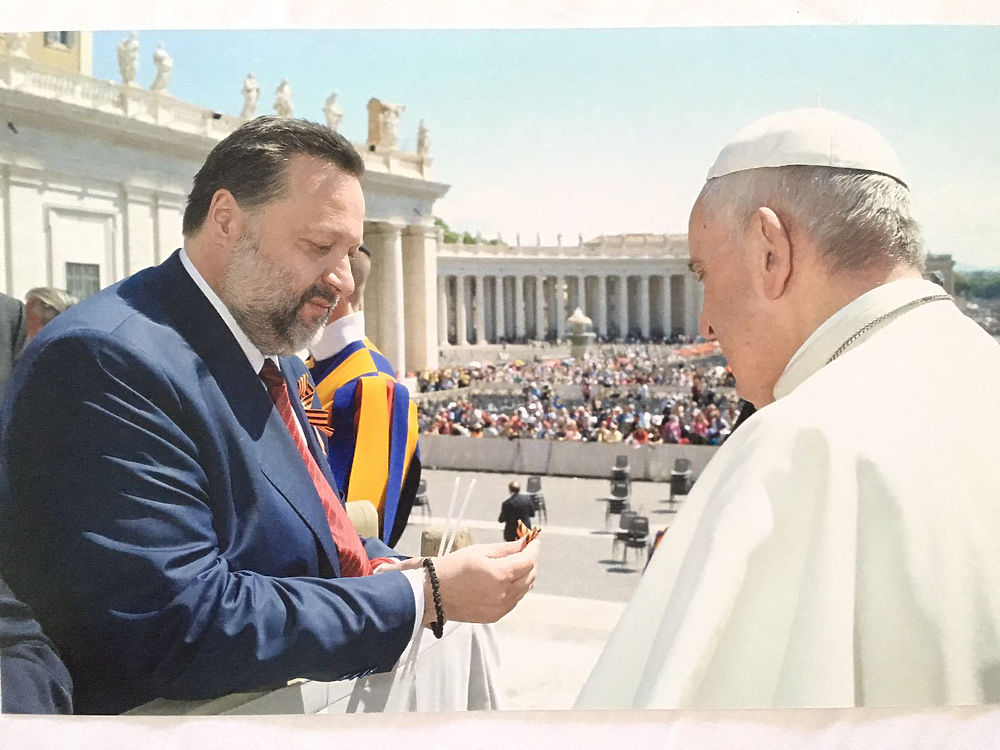
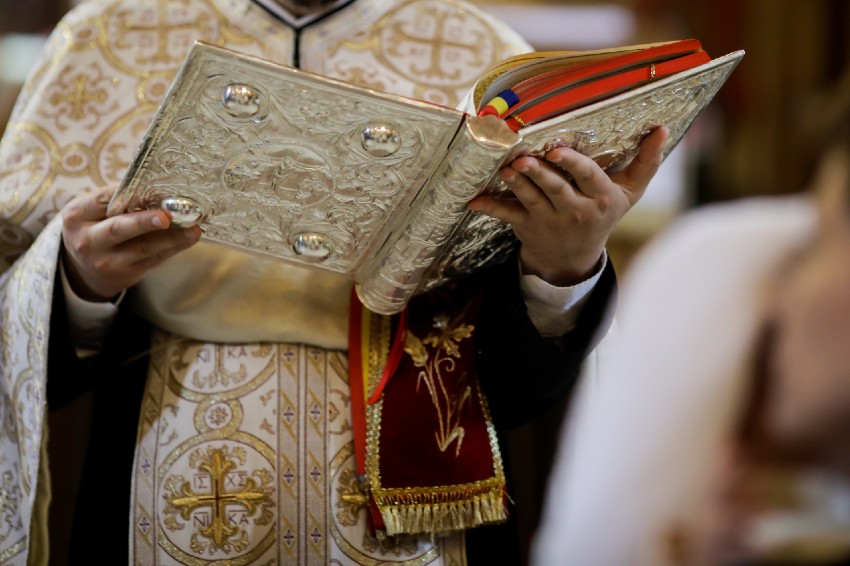
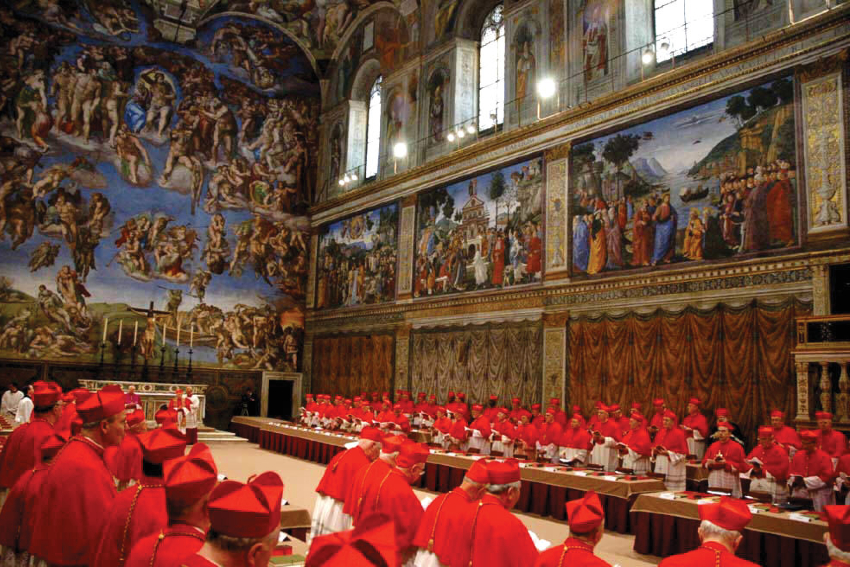
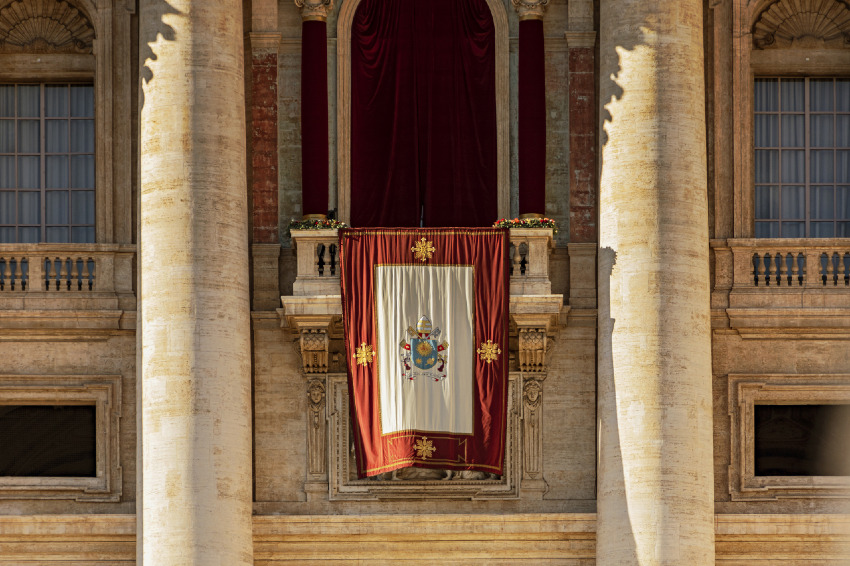
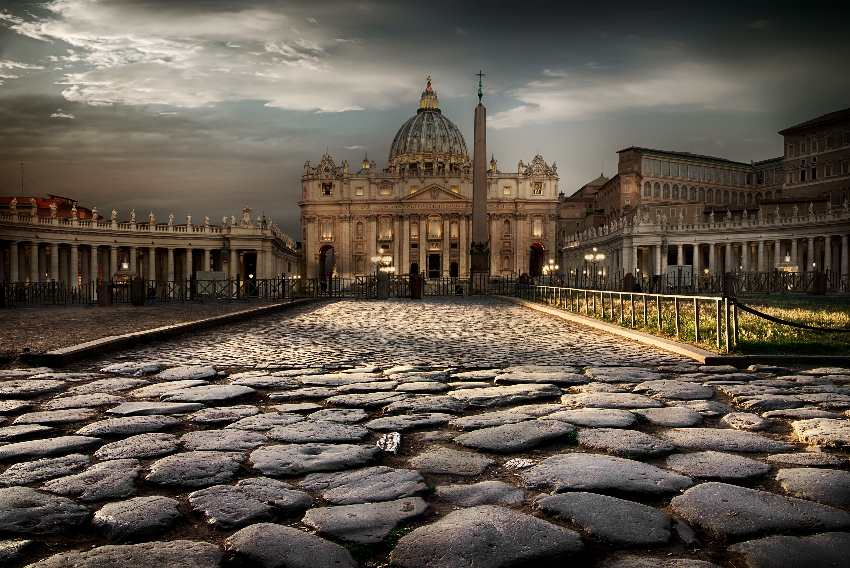

Facebook Comments